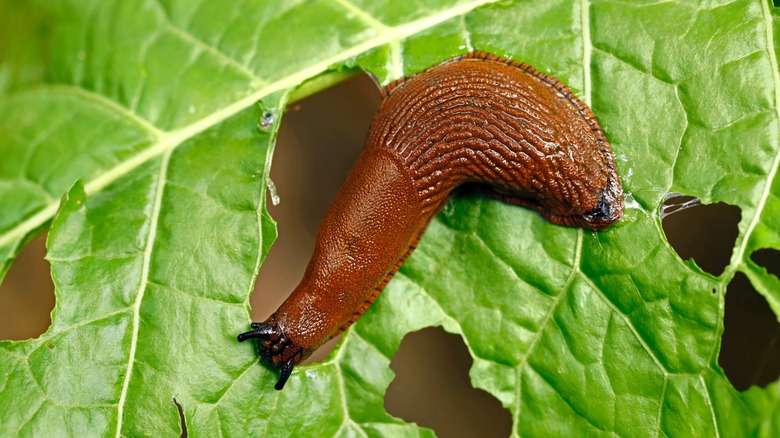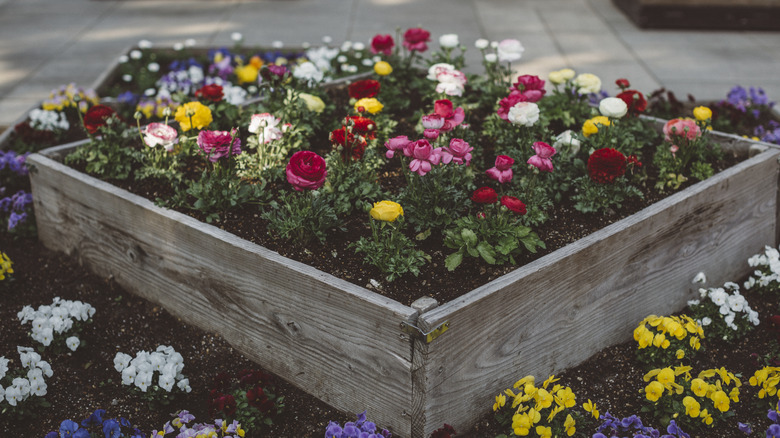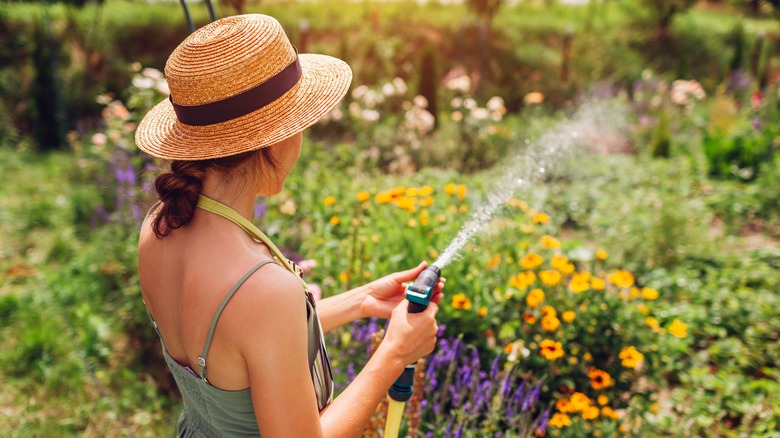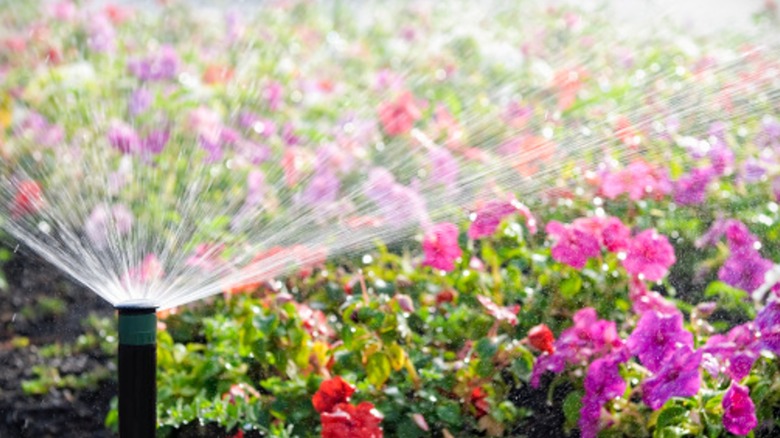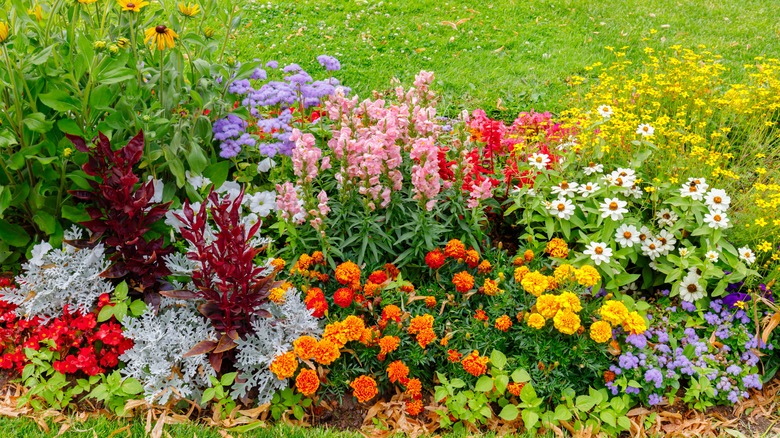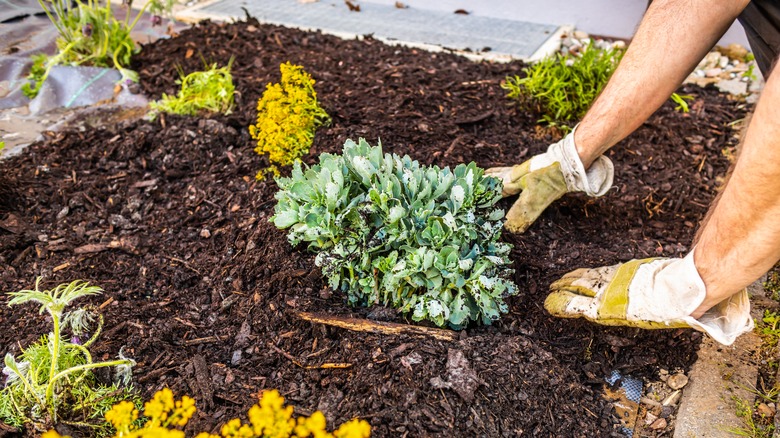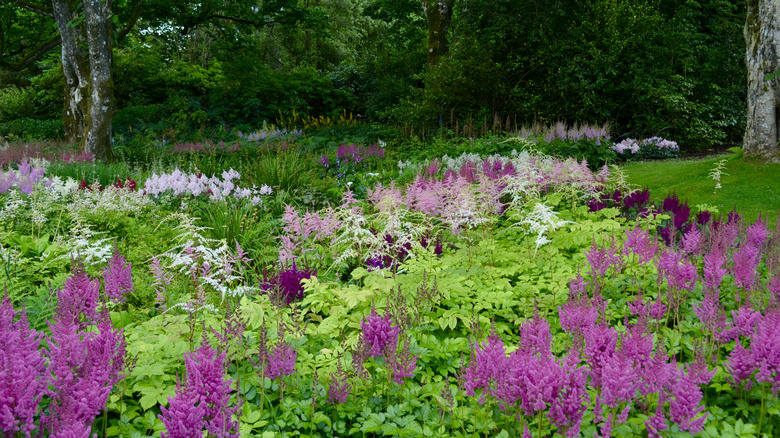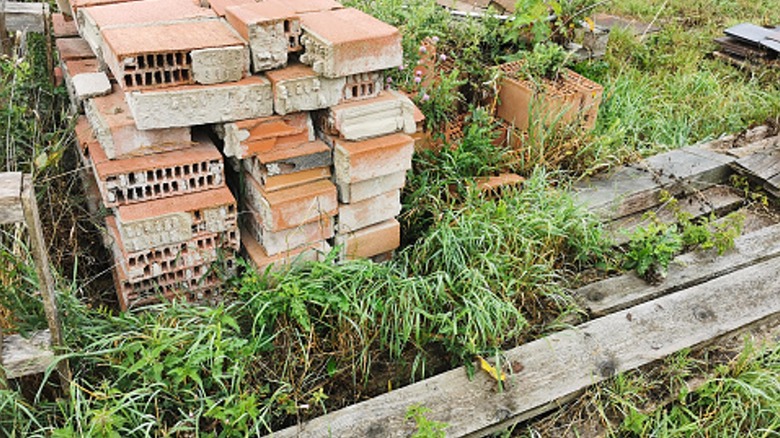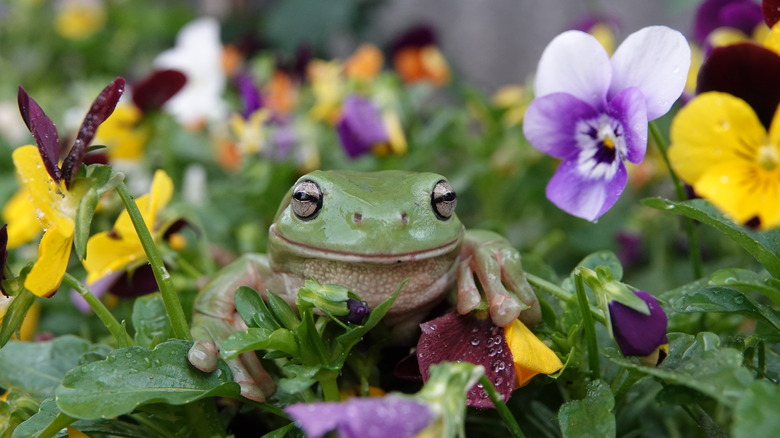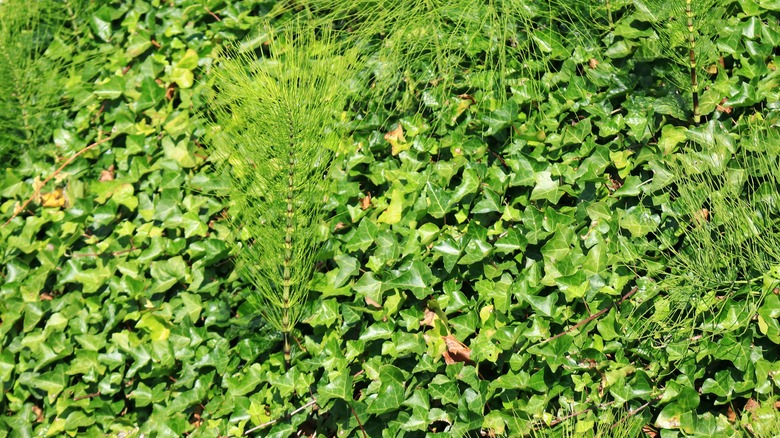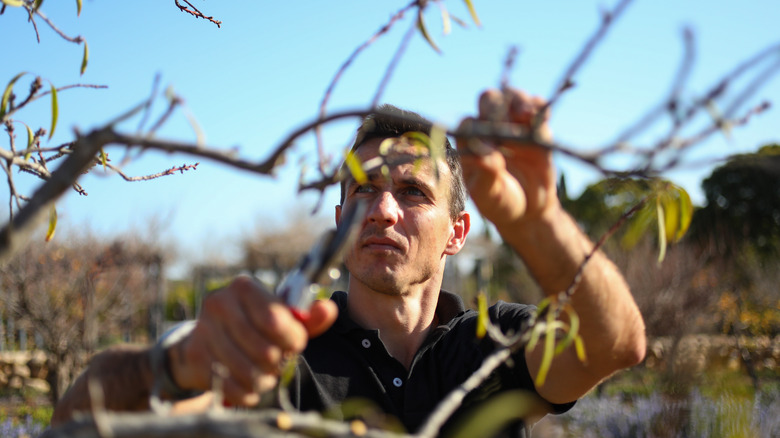Common Gardening Mistakes That Are Attracting Slugs To Your Yard
No one wants to find slugs — or evidence of their presence — in their yard or garden. These pests, which have soft and slimy bodies, can wreak havoc on a garden. Their mouthparts, known as radula, work similarly to a file, cutting and chewing off leaves and other plant parts. If you notice odd-shaped and jagged holes in your plants, it is a sign that slugs have been feasting on them. While you almost certainly want to keep slugs out of your yard and garden, did you know that, unknowingly, you may actually be welcoming them to come and make themselves at home?
There are several gardening mistakes that people make that can inadvertently attract slugs to their gardens. Mistakes related to watering and mulching your garden, spacing out your plants, and general care of the area can cause slugs to come and begin feasting on your plants. Ahead, we'll explore some of the most common gardening mistakes you'll want to avoid and explain what you should do instead to keep the slugs far away from your precious plants.
Building raised garden beds out of wood
There are many benefits associated with using raised garden beds. They let your garden really stand out and increase its visual appeal, make it easier to control the soil structure for overall plant health, and help ensure that the soil is able to drain properly. In many cases, raised beds can even work to protect plants from pests. However, if you've built your raised garden beds out of wood, they're likely going to have the opposite impact on your garden and may actually attract slugs to it.
Using wood for your raised garden beds can be a serious mistake. Wooden garden beds — particularly those made from untreated wood — keeps the soil around the bed moist. Because slugs like moist environments, they'll be much more likely to flock to these areas around your garden beds. While raised beds made from pressure treated wood are less likely to attract slugs, it still isn't the optimal material. Instead, consider other material types — such as stones, cinder blocks, and steel — when constructing your garden beds.
Watering your plants in the evening
When you're looking for the best tips to keep snails and slugs out of your garden, knowing when to water your plants is crucial. As mentioned earlier, slugs prefer a moist environment. These pests are also nocturnal, meaning they are active at night. For this reason, watering your plants in the evening can be a serious mistake. You'll be creating the preferred environment for the slugs just as they're about to become active. In essence, you're giving slugs the perfect buffet conditions and encouraging them to come and feast in your garden.
Instead, opt to water the plants in your garden in the morning. This way, the plants and the soil will have absorbed most of the water by the evening. These drier conditions will be much less favorable to the slugs. Just remember to water early enough in the day before the sun gets too strong. Even though it'll likely dry up by night if you water around noon, watering during the heat of the day can cause other problems for your plants: The leaves may become scorched if the sun magnifies drops of water on the leaves.
Over-irrigating your garden
Knowing the proper time of day to water your plants is only one step in keeping slugs out of your garden. If you over-irrigate the garden — regardless of whether you're watering in the morning or the evening — it is going to create the damp conditions that slugs love. One of the top ways to keep slugs away or encourage them to leave your garden is to reduce humidity levels.
One essential step is to make sure that you aren't overwatering your plants. Sprinkler systems and flood irrigation can saturate the soil and make it excessively damp and humid. Overwatering by hand can have a similar effect. One solution to reduce the dampness and humidity levels of your garden is to switch to using a drip irrigation system. This type of system delivers water at a much slower rate. However, since the water is applied right at the root zone, the plants still get the moisture they need to grow.
Spacing plants too closely
The layout and design of your garden may also be attracting snails. If you have too many plants and flowers crammed into the garden bed, it can inhibit airflow. As you can probably guess, when there is less airflow, the plants and soil will remain damp for longer, encouraging snails to come, make themselves comfortable, and have a snack.
Instead, be sure to leave space between your plants when laying out your garden. With proper spacing, air will be able to flow more freely and prevent conditions from getting overly humid and attractive to slugs. Similarly, avoid placing plants too close to hedges, garden walls, or anything else that will interfere with proper airflow. Monitor the growth of your flowers and plants, and prune them as necessary to maintain sufficient open space.
Choosing the wrong mulch
Did you know that all mulches are not created equal when it comes to their fitness for your garden? In fact, the wrong mulch could be adding to a slug problem in your yard. Carefully choosing the best type of mulch for your garden can prevent you from creating conditions that are more attractive to slugs to keep them out of your space. If you've been using decomposing organic matter as the mulch for your garden, then you've just identified one mistake that could be contributing to a slug problem.
One important task slugs have is to clean up decomposing matter. So, if you're laying leaves or only partially decomposed compost, then the slugs are going to flock to the area to feed on it. Instead, opt for organic matter that is already fully decomposed, such as a fine compost with no still-decaying matter in it. When spreading mulch over your garden, you will also want to avoid making your layers too thick to prevent the retaining of excess moisture in the soil, which makes the environment humid and more attractive to slugs.
Not opting for slug-resistant plants
Just as certain plants are more deer-resistant than others, the same is true for slugs. It is only logical that if your garden is filled with plants that slugs prefer to eat, then the pests are going to flock to the space. A few of the plants that slugs particularly enjoy include lettuce, strawberries, daffodils, hostas, lilies, basil, impatiens, and wild ginger.
Instead, opt for slug-resistant plants. Slug-resistant plants may be tough or leathery, making them more challenging for a slug to chew. Others may have hairy leaves, which makes it difficult for slugs to grab onto them using their teeth. Still, others may have poisonous leaves, overly strong odors, or red or purple foliage, which the snails do not like. A few slug-resistant plants you can consider include wintergreen, astilbe, candytuft, sweet woodruff, and Solomon's seal. As you're researching more resistant plants, stay away from invasive species, such as bamboo, Nandina, or English ivy, that can create new problems for your yard and garden.
Providing too many hiding places for the slugs
If you want to keep slugs from snacking on your roses and the other plants in your garden, then it is essential to eliminate as many hiding places as possible. As nocturnal creatures, slugs stay hidden during the day. When choosing a spot to hide, slugs look for damp and dark areas. If your garden has these spaces to offer, it is more likely that the slugs will set up camp during the day and then come out at night to start eating your plants.
Assess your garden, keeping an eye out for anywhere that might look like an appealing hiding place for a slug, and eliminate as many of these spaces as possible. Some potentially attractive hiding places including stick piles, empty pots or containers, and rotting wood. Other steps you can take to reduce hiding spots include cutting back the lower leaves of your plants to prevent them from touching the soil, keeping grass short, and weeding your garden regularly.
Overlooking the benefits of welcoming natural slug enemies
Slugs won't be able to eat your hydrangeas and other plants if they're prevented from entering your garden in the first place. Don't overlook the benefits of welcoming some natural slug predators and letting them help you cut back on the slug population. Natural predators of slugs include garter snakes, ground beetles, birds, frogs, and ducks.
Consider making your garden more inviting for these slug enemies to encourage them to visit and eat some of the invading slugs. For example, you can make your garden more attractive to birds by adding a water source, installing bird feeders, or providing materials for nesting. Similarly, if you're looking to attract frogs, consider planting native plants and adding a small pond with stones around the edges. When applying insecticides to deal with other pests, also consider how they may negatively impact the wanted wildlife in the garden. It may be best to choose a more targeted approach to avoid killing or chasing away the natural predators that you want to remain in the space.
Going all out on ground covers
There are several reasons you may be considering adding ground covers to your yard or garden. They can often help prevent weeds from growing and spreading, add color and style to your yard, and even reduce runoff. However, if you're already dealing with a slug problem — or want to do everything in your control to prevent one from popping up — going all out on ground covers may be a mistake. As mentioned above, slugs look for cool and dark places to hide, and ivy, vinca, and other types of ground cover can provide these conditions.
If you don't want to completely eliminate ground covers, then the next best course of action will be to be very purposeful with which plants to place near these covers. Avoid planting slug-favorites, like broccoli, dahlias, or hostas, near the ground cover. Since the slugs will already be drawn to these plants, they'll be much more likely to stick around if they find a nearby hiding place in an adjacent ground cover.
Not pruning trees and shrubs
Allowing your trees and shrubs to become overgrown does more than just make your landscaping look unappealing — it may be attracting slugs to your space. While it is rare for slugs to cause damage to the trees or bushes themselves, when these landscaping elements are overgrown, they help create those cool and damp hiding places in your garden that the slugs are looking for. Less light is able to filter through the trees and bushes. This means that the plants and soil beneath them remain damp for longer periods of time. Heavier branch covering can also restrict airflow, further exacerbating the damp conditions.
To avoid this problem, regularly prune your trees and shrubs. Pay particular attention to the lower branches. Keeping these trimmed back will have the greatest impact on the amount of light that is able to reach the plants. It will also facilitate airflow to prevent the soil from remaining overly moist.
